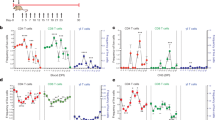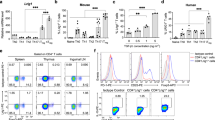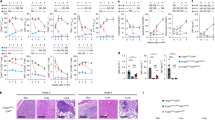Abstract
Down-regulatory phenomena have been described in several experimental models of tissue-specific, T-cell-mediated autoimmunity. For example, resistance to active induction of experimental autoimmune encephalomyelitis (EAE) can be induced by pretreating animals with non-pathogenic inocula of autoantigen1 or effector cells2,3. Moreover, animals that have recovered from one EAE episode are resistant to subsequent induction of EAE4–6. In some models, resistance to EAE has been transferred with immune cells to naive recipients7–12. These experiments, which were based on transfers of unseparated immune cell populations, are difficult to intepret. Immune suppression circuits are known to be complex and involve various distinct cellular subsets13. To further complicate the issue, resistance to EAE can be transferred not only by suppressor cells, but also by encephalitogenic effector cells injected in 'subclinical' doses2,12. We describe now the isolation of homogenous T lymphocyte lines from the spleens of Lewis rats that had recovered from T-cell-mediated EAE (tEAE) caused by the MBP-specific T cell line SI. These spleen-derived T line cells express the CDS phenotype and specifically respond to determinants on the inducing SI line, but not to the autoantigen MBP. Furthermore, the anti-Si cells selectively lyse the encephalitogenic SI T line in vitro and efficiently neutralize their encephalitogenic capacity in vivo.
This is a preview of subscription content, access via your institution
Access options
Subscribe to this journal
Receive 51 print issues and online access
$199.00 per year
only $3.90 per issue
Buy this article
- Purchase on Springer Link
- Instant access to full article PDF
Prices may be subject to local taxes which are calculated during checkout
Similar content being viewed by others
References
Alvord, E. C., Shaw, C. M., Hruby, S. & Kies, M. W. Ann. N. Y. Acad. Sci. 122, 333–345 (1965).
Driscoll, B. F., Kies, M. W. & Alvord E. C. J. Immun. 128, 635–638 (1982).
Ben-Nun, A., Wekerle, H. & Cohen, I. R. Nature 292, 60–61 (1981).
McFarlin, D. E., Blanck, S. E. & Kibler, R. F. J. Immun. 113, 712–715 (1974).
Willenborg, D. O. J. Immun. 123, 1145–1150 (1979).
Ben-Nun, A. & Cohen, I. R. J. Immun. 128, 1450–1457 (1982).
Adda, D. H., Beraud, E. & Depieds R. Eur. J. Immun. 7, 620–623 (1977).
Bernard, C. C. A. Clin. exp. Immun. 29, 100–109 (1977).
Swierkosz, J. E. & Swanborg, R. H. J. Immun. 115, 631–633 (1975).
Welsh, A. M., Holda, J. H. & Swanborg, R. H. J. Immun. 125, 186–189 (1980).
Lando, Z., Teitelbaum, D. & Arnon R. J. Immun. 126, 1526–1528 (1981).
Schluesener, H. J. thesis, Würzburg Univ. (1985).
Asherson, G. L., Colizzi, V. & Zembala, M. A. Rev. Immun. 4, 37–68 (1986).
Fierz, W., Endler, B., Reske, K., Wekerle, H. & Fontana A. J. Immun. 134, 3785–3793 (1985).
Mason, D. W., Arthur, R. P., Dallman, M. J., Green, J. R., Spickett, G. P. & Thomas, M. L. Immun. Rev. 74, 57–82 (1983).
Wekerle, H., Linington, C., Lassmann, H. & Meyermann, R. Trends Neurosci. 9, 271–277 (1986).
Sun, D. & Wekerle, H. Nature 320, 70–72 (1986).
Heuer, J., Brüner, K., Opalka, B. & Kölsch, E. Nature 296, 456–458 (1982).
Lamb, J. R. & Feldman, M. Nature 300, 456–458 (1982).
Mohagheghpour, N., Damle, N. K., Takada, S. & Engleman, E. G. J. exp. Med. 164, 950–955 (1986).
Deusch, K., Moebius, U., Meyer zum Büschenfelde, K.-H. & Meuer, S. C. Eur. J. Immun. 16, 1433–1438 (1986).
Modlin, R. L. et al. Nature 322, 459–461 (1986).
Ottenhoff, T. H. M., Elferink, D. G., Klatser, P. R. & deVries, R. R. P. Nature 322, 462–464 (1986).
Hochgeschwender, U., Weltzien, H. U., Eichmann, K., Wallace, R. B. & Epplen, J. T. Nature 322, 376–378 (1986).
Hochgeschwender, U., Simon, H.-G., Weltzien, H. U., Bartels, F., Becker, A. & Epplen, J. T. Nature 326, 307–309 (1987).
Author information
Authors and Affiliations
Rights and permissions
About this article
Cite this article
Sun, D., Qin, Y., Chluba, J. et al. Suppression of experimentally induced autoimmune encephalomyelitis by cytolytic T–T cell interactions. Nature 332, 843–845 (1988). https://doi.org/10.1038/332843a0
Received:
Accepted:
Issue Date:
DOI: https://doi.org/10.1038/332843a0
This article is cited by
-
Brain borders at the central stage of neuroimmunology
Nature (2022)
-
Antiviral CD8+ T cells cause an experimental autoimmune encephalomyelitis-like disease in naive mice
Journal of NeuroVirology (2012)
-
Novel therapeutic strategies for multiple sclerosis — a multifaceted adversary
Nature Reviews Drug Discovery (2008)
-
Multiple sclerosis therapy: An update on recently finished trials
Journal of Neurology (2007)
-
Experimental autoimmune encephalomyelitis: Cytokines, effector t cells, and antigen-presenting cells in a prototypical th1-mediated autoimmune disease
Current Allergy and Asthma Reports (2003)
Comments
By submitting a comment you agree to abide by our Terms and Community Guidelines. If you find something abusive or that does not comply with our terms or guidelines please flag it as inappropriate.



